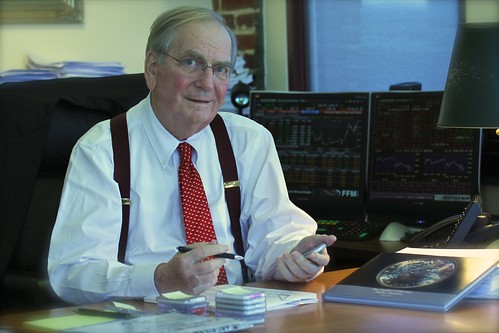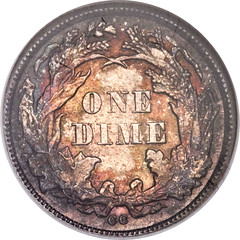
PREV ARTICLE
NEXT ARTICLE
FULL ISSUE
PREV FULL ISSUE
INTELLIGENT COLLECTOR INTERVIEWS GENE GARDNER
The Summer 2014 issue of Heritage's Intelligent Collector magazine has a nice cover article about collector Gene Gardner of Lancaster, PA. Many thanks to editor Hector Cantu for forwarding the text and images for the following excerpt. Heritage will begin auctioning Gardner's massive collection of U.S. coins on June 23rd in New York.
It is considered one of the finest collections of U.S. silver coinage ever assembled.
-Editor

When did you make the jump from kid collector to spending serious money as a serious collector? It started in 1955. Coin prices were not that high. If you spent $10 or $15 on a coin, that was something. I collected a whole set of Indian proof pennies that were part of the estate of [noted numismatist] Wayte Raymond [1886–1956], and those were gorgeous. They would be [grade level] 67s, at least, today, perhaps 68s. They were truly gorgeous, but they cost 10 bucks. I sold those in 1965, 10 years later, for about $60 or $70. The coins were special. They brought a high price. Today, they would be hundreds or thousands of dollars. So when you ask when I first spent real money on coins, I don’t remember. But it was not significant. It was a little bit here and there. You purchased coins from the Jordan Marsh department store in Boston back then? They had a coin department in the basement. They didn’t have super coins, but they had interesting coins, and I bought several. I got to know the dealers in the Boston area. Malcolm Chell-Frost was a person I was close to. I didn’t realize it at the time, but he was really nationally known. He was a contributor to the Red Book guide, a significant numismatist, and a terrific person. The first real coins I bought were from him. I would go down there two or three times a week and he would ration them out to me. I knew he had more, but he would only sell you a couple at a time. After your 1965 auction, what brought you back to collecting? It was just a random chance. I was in New York one day, walking along 57th Street, and I walked past Stack’s and something was going on. They were having an auction that night, so I stayed around. It was sticker shock. It was unbelievable. Coins I thought were worth $10, $15 or $20 were suddenly worth $1,000, $1,500, $2,000. But I couldn’t sit still for the whole thing so I bought a 1909-S VDB Lincoln cent. Not a particularly distinguished coin. I paid $935 for it in 1995. It was OK, but it wasn’t the quality I actually would go after. I was very uncertain. I sort of spent the rest of 1995 being about that serious … nosing around but not doing much about it. And then in 1996 was the Eliasberg auction, and that was my first real jump back in. The second time around, you were more focused? Well, I had some knowledge, but not enough to really be successful. For instance, when the Eliasberg coins went up for sale, I bought an 1876-CC Liberty Seated 20-cent piece. I knew it was a rare coin and it was the fifth auction lot, so I just bought it. I had no idea if I’d paid too much or too little. I paid $148,500 for it, which at the time everybody seemed to think was a remarkable price. The good news is it’s worth more today. The coins in Eliasberg were all raw. They were not graded. So it was dependent on your ability to grade, and frankly my ability to grade was zero – certainly compared to the people I was competing with, who were some of the real experts in the field. But I was familiar with rarities.


Why have you focused on Seated Liberty coins? That’s just the way the collection developed. I’ve wound up with an unbelievable collection of Liberty Seated coins. I’ve collected all series. The dollars, half dollars, quarters, dimes, half dimes. They are all complete, in high-grade mint state, probably averaging [a grade of] close to 65 and 66. And I’ve also collected them complete in proof, from 1837 to 1891 – in all series, missing only one coin, the 1853 half dime. That’s the way the collection developed. I always had an affinity for the quarters. People kept saying “You’ll never complete the quarters. You just can’t do it. They are the toughest series to complete in highest quality.” That just spurred me on.
We've discussed department store coin shops before, but I don't think we've ever had a mention of Malcolm Chell-Frost. Martin Gengerke lists four auction sales by "Malcolm O. E. Chell-Frost aka Boston Towne Brokerage Coin Exchange" from 1944 (three in Numismatic Scrapbook Magazine). Can anyone tell us more about him?
-Editor
To read the complete issue online, see:
www.intelligentcollector.com/mag/2014-5/
The Numismatic Bibliomania Society is a non-profit organization promoting numismatic literature. See our web site at coinbooks.org. To submit items for publication in The E-Sylum, write to the Editor at this address: whomren@gmail.com To subscribe go to: https://my.binhost.com/lists/listinfo/esylum All Rights Reserved. NBS Home Page Contact the NBS webmaster 
|